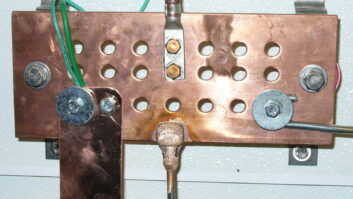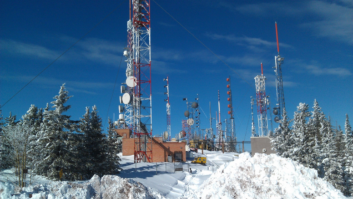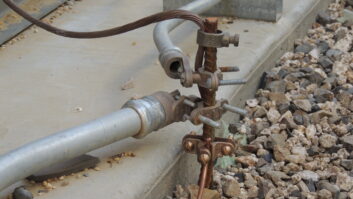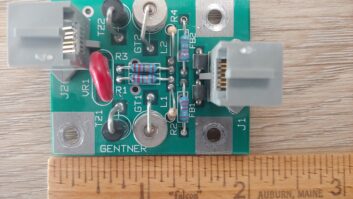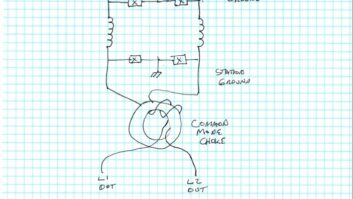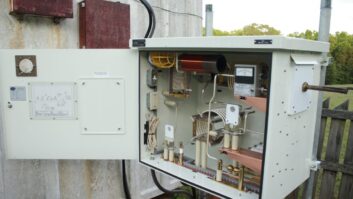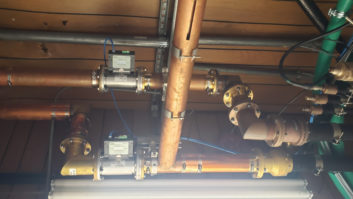The first in a three-part series.
In 1752, Benjamin Franklin performed his famous experiment, flying a kite during a thunderstorm and thus proving that lightning and electricity were somehow related. It’s interesting how the very phenomenon that started it all has ever since been the bane of all things electrical and electronic.
Communications installations, including broadcast facilities, most often utilize height as a critical variable in the all-important propagation equation, and as such, produce an analog to the conditions under which old Ben coaxed a lightning strike out of a thunderstorm. The difference is, Ben was looking for a strike while in the case of communications installations, a lightning strike is the last thing we want.
Discharge
We have learned a great deal about lightning since 1752, but perhaps the most important thing we have heard is that lightning is unpredictable.
(click thumbnail)A direct hit to the antenna produced ‘collateral damage’ down the transmission line.
In reality, everything about lightning actually is very predictable, with every aspect conforming to the unalterable laws of physics. What makes it unpredictable from our perspective is that there are an impossibly large number of variables; we simply cannot know all the factors that enter the equation in a particular situation.
The type of lightning that does damage to broadcast installations is the discharge of energy from an electrically charged cloud to the ground. Cloud-to-cloud discharges seldom cause damage on the ground. Here’s what we know about the anatomy of a “typical” cloud-to-ground lightning strike.
When lightning strikes the earth or an object on the earth, a more-or-less usual sequence of events occurs. First, downward “leaders” from a highly-charged thunderstorm cloud pulse toward the earth, seeking out electrical ground targets. Objects on the ground, such as buildings, trees, power lines and radio towers, emit differing amounts of electrical activity during this event. Streamers are launched upward from some of these objects. Some of the downward-going leaders connect with some of the upward-reaching streamers. It is at this point that the circuit is completed and current flows. The arc is then visible, and the superheated air displaced by it creates the thunderclap.
It’s not unusual for a lightning strike to have a peak amplitude of 20,000 amps and last 40 microseconds to half amplitude. Some lightning pulses can reach 400,000 amps and reach temperatures of 50,000 degrees Fahrenheit. The rise time of a typical strike is about 5 microseconds to peak amplitude.
The current path in a lightning strike is from the cloud to what we call “ground.” A perfect ground connection, however, does not really exist, and any real ground connection will have both a finite DC resistance and AC impedance of from several ohms to several hundred ohms.
Applying Ohm’s Law, you can see that a large potential can be developed from a ground connection to “real” ground. Several million peak volts or more can easily be developed in such a situation.
Harm
Broadcast facilities are damaged by lightning in several different ways.
First, a direct hit on an FM antenna or transmission line often does physical damage. At the point of contact, the metal is often melted, creating a hole in the antenna or line. It’s often at this point where the failure occurs.
Lightning energy actually penetrates the outer metal casing and produces an internal arc that is sustained by the RF energy long after lightning current itself has ceased to flow. In many cases, it’s this secondary RF arc that actually does the most damage.
When lightning hits an AM tower, at least part of the discharge current flows into the antenna tuning unit. If the potential is high enough at that point, it can cause capacitors in the tuning network to fail by exceeding their maximum operating voltage. The dielectric is compromised and a short circuit is produced. Mica transmitting capacitors are produced by combining series and parallel capacitor elements and potting them into a single package. Sometimes, lightning can short just one of the series elements, causing the overall value of the capacitor to change significantly. If the lightning potential is high enough at the input of the ATU network, it can cause the transmission line to arc over. As with FM antennas and transmission lines, it’s often a secondary RF arc, sustained by RF from the transmitter, that does the real damage.
We can all understand that a direct hit on a tower or antenna can be devastating. It’s a little harder to understand how lightning can cause damage indirectly.
I’ve heard some folks comment that the lightning hit the tower and must have “jumped over” to some other structure or cable to do secondary damage. While that can and does happen, more often the secondary damage comes from the very high localized magnetic field the high current from the strike produces.
Consider the case where lightning hits the STL tower behind the studio building. The STL transmitter is fine after the strike, but network cards have failed in computers all over the building. Why? The very high current flowing in the steel STL tower during the strike event produced a very high magnetic field. Those lines of flux were cut by the wires in the Ethernet cabling running through the ceiling and a significant voltage was induced.
Those NICs were never intended to handle several hundred volts of potential on their Ethernet ports, and something has to give. Lightning current never touched the cables or NICs, but they were destroyed anyway.
A number of years ago, lightning struck the amateur radio tower behind my house. I was there at the time and observed that the flash and impossibly loud thunderclap were simultaneous.
The top 2-meter vertical antenna was literally blown in half (I later found the top part stuck in the ground like a javelin), and the radio to which it was connected and its power supply were completely destroyed.
As my wife and I began assessing what other damage had occurred in the house, we turned on the television in the living room. It worked — we had a picture and sound — but the screen was a rainbow of colors that didn’t belong. It took degaussing with a big degaussing ring to restore proper color. The magnetic field from the strike had magnetized the steel in the set.
Making things worse
In many cases, bad engineering leads directly to damage from lightning. The very measures that were intended to protect the transmitter and other equipment from lightning damage actually contribute to that damage.
In a typical broadcast transmitter or tower site, there is a ground at the tower base and a number of other ground points. The current from a lightning strike will see several parallel paths to ground.
For example, the ground rod(s) at the tower base will be one path, the outer jacket of the transmission lines through the equipment cabinets to the transmitter building ground will be another, and the AC safety ground wiring to the distribution panel ground on the tower light wiring still another path.
If you can imagine an equivalent circuit of these several resistive paths in parallel, you will be able to grasp the idea that even with a solid ground at the base of the tower, large and damaging potentials can be developed across the other paths. Keep in mind that the fast-rise-time currents will flow in all these paths, producing damaging magnetic fields just as the main strike current produces
Eliminating all the parallel ground paths and providing a single, low-impedance path to ground for lightning energy is the key to mitigating damage from strikes. A key component in this low-Z ground path is the ground electrode or ground rod. That’s where we’ll resume our discussion next time.






